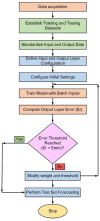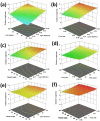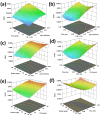Multi-objective optimization of surface finish and VOC emissions in FFF 3D printing using ANN-NSGA-II approach
- PMID: 41038994
- PMCID: PMC12491562
- DOI: 10.1038/s41598-025-17304-7
Multi-objective optimization of surface finish and VOC emissions in FFF 3D printing using ANN-NSGA-II approach
Abstract
Fused filament fabrication (FFF) is a widely adopted 3D printing technique for the rapid, cost-effective, and customized fabrication of complex microfluidic channels using polylactic acid (PLA), particularly for drug delivery and biomedical applications. However, achieving optimal surface finish and minimizing volatile organic compound (VOC) emissions during printing remains a substantial challenge. The current study proposes a new approach by integrating a hybrid framework of artificial neural networks (ANN) with the non-dominated sorting genetic algorithm II (NSGA-II) to enhance both the quality and environmental safety of the FFF 3D printing process for microfluidic channel applications. The proposed approach optimizes four key process parameters such as layer thickness (LT), print speed (PS), material flow rate (MFR), and raster angle (RA) with a prime objective of obtaining an excellent surface finish with minimum VOC emissions. A customized FFF 3D printer embedded with cost-effective, high-sensitivity emission sensors was designed and developed to facilitate real-time monitoring, thereby offering a unique and economical capability not available in conventional commercial printers. Experimental data generated using central composite design (CCD) were employed to train a high-fidelity ANN model (R² > 95%), which functions as a surrogate model for NSGA-II-based multi-objective optimization. The ANN model demonstrated strong predictive accuracy with low mean squared error (MSE) and high correlation coefficients (R² = 0.9967 for training, 0.956 for validation, and 0.9261 for testing). The proposed ANN-NSGA-II framework identified Pareto-optimal solutions at LT (0.15 mm), PS (40 mm/s), MFR (100%), and RA (30º). The optimization results demonstrate effective control of process parameters, yielding the dual benefit of enhanced surface finish and reduced VOC emissions. The novelty of this work lies in integration of real-time emission sensing with predictive intelligence and evolutionary multi-objective optimization, ensuring high print quality while simultaneously advancing environmentally responsible additive manufacturing (AM) practices.
Keywords: Additive manufacturing; Fused filament fabrication; Multi-objective optimization; NSGA II; Process parameter optimization; Surface roughness; VOC emissions.
© 2025. The Author(s).
Conflict of interest statement
Declarations. Competing interests: The authors declare no competing interests.
Figures














References
-
- Taufik, M. & Jain, P. K. Additive Manufacturing with Interdisciplinary Applications. in Lecture Notes in Mechanical Engineering 183–210Springer Science and Business Media Deutschland GmbH, (2024). 10.1007/978-981-99-6601-1_17
-
- Bhandari, S., Krishnanand, Roy, S., Singh, A. & Taufik, M. Design and fabrication of accelerometer sensor using fused filament fabrication technique. Progress Additive Manuf.10, 2473–2486 (2025).
-
- Chaudhary, S., Avinashi, S. K., Rao, J. & Gautam, C. Recent advances in additive manufacturing, applications and challenges for dentistry: A review. ACS Biomater. Sci. Eng.9, 3987–4019 (2023). - PubMed
-
- ÇETİN, E. & TÜRKAN, O. T. Material recycling of acrylonitrile butadiene styrene (ABS) from wiring devices using mechanical recycling. Sustainable Chem. Environ.6, 100095 (2024).
LinkOut - more resources
Full Text Sources

